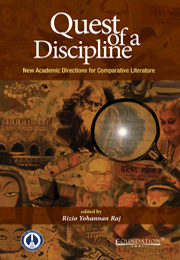Book contents
- Frontmatter
- Contents
- List of Contributors
- Acknowledgements
- Prologue to the “Quest'
- Introduction
- PART I Traditions and Manifestoes: Reflecting on Perspectives
- 1 The Comparatist as Teacher: Teaching Indian Literatures through a Comparative Methodology
- 2 Comparative Literature: Methodology and Challenges in Europe with Special Reference to the French and German Contexts
- 3 ‘Lone Starring’ Comparative Literature in US English Departments
- PART II The Quest Motif: Redefining the Scope of Comparative Literature
- PART III The Dynamics of Exchange: Genres, Areas and Disciplines
- PART IV India: A Curious Comparative Space
- Afterword: Comparative? Literature?
- Index
3 - ‘Lone Starring’ Comparative Literature in US English Departments
from PART I - Traditions and Manifestoes: Reflecting on Perspectives
Published online by Cambridge University Press: 05 June 2012
- Frontmatter
- Contents
- List of Contributors
- Acknowledgements
- Prologue to the “Quest'
- Introduction
- PART I Traditions and Manifestoes: Reflecting on Perspectives
- 1 The Comparatist as Teacher: Teaching Indian Literatures through a Comparative Methodology
- 2 Comparative Literature: Methodology and Challenges in Europe with Special Reference to the French and German Contexts
- 3 ‘Lone Starring’ Comparative Literature in US English Departments
- PART II The Quest Motif: Redefining the Scope of Comparative Literature
- PART III The Dynamics of Exchange: Genres, Areas and Disciplines
- PART IV India: A Curious Comparative Space
- Afterword: Comparative? Literature?
- Index
Summary
INTRODUCTION
Gayatri Spivak's provocative title to her 2000 Wellek library lecture series on Comparative Literature speaks of the ‘death’ of the discipline as traditionally understood in the Euro-American academy. This is in fact a call for the discipline's revitalisation by an alliance with Area Studies towards a ‘planetary’ consciousness. Almost a decade ago, Susan Bassnett had written of Comparative Literature in similar terms: ‘Today, Comparative Literature in one sense is dead [….] but it lives on in other guises.’ Some of these ‘guises’ identified by Bassnett included a reworking of disciplinary boundaries through the insights of Gender and Cultural Studies and the possibilities of intercultural transfer offered by Translation Studies (Comparative 47). Even a cursory examination of literature on the state of Comparative Literature as a discipline and its methodology reveals that neither Bassnett nor Spivak are calling for doing away with Comparative Literature but rather asking us to make it more relevant to our times.
This brief history is meant as a prelude to some of the battles I witnessed as a newly appointed specialist in Postcolonial Literature at a large public university in West Texas and the only one in the region which has faculty specialising in Comparative Literature. The irony of teaching Postcolonial Studies at a public university in the Lone Star State is obvious. The region's history of territorial control over land that was once part of Mexico, its stringent border policing to stop Mexicans from crossing over into territory they originally owned, and the dubious distinction of educational institutions in Texas as being the last few anywhere in the world to recognise the importance of Postcolonial Studies are some facets of the irony.
Information
- Type
- Chapter
- Information
- Quest of a DisciplineNew Academic Directions for Comparative Literature, pp. 49 - 60Publisher: Foundation BooksPrint publication year: 2012
